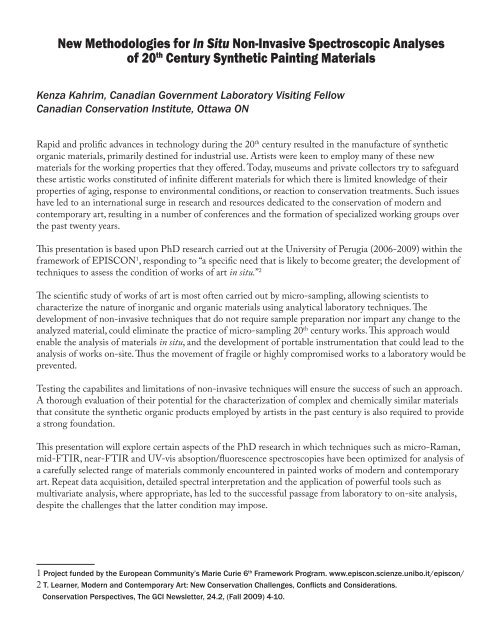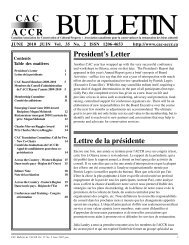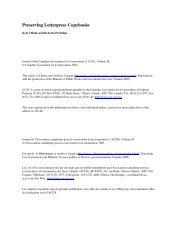Ottawa - Canadian Association for Conservation
Ottawa - Canadian Association for Conservation
Ottawa - Canadian Association for Conservation
You also want an ePaper? Increase the reach of your titles
YUMPU automatically turns print PDFs into web optimized ePapers that Google loves.
New Methodologies <strong>for</strong> In Situ Non-Invasive Spectroscopic Analyses<br />
of 20 th Century Synthetic Painting Materials<br />
Kenza Kahrim, <strong>Canadian</strong> Government Laboratory Visiting Fellow<br />
<strong>Canadian</strong> <strong>Conservation</strong> Institute, <strong>Ottawa</strong> ON<br />
Rapid and prolific advances in technology during the 20 th century resulted in the manufacture of synthetic<br />
organic materials, primarily destined <strong>for</strong> industrial use. Artists were keen to employ many of these new<br />
materials <strong>for</strong> the working properties that they offered. Today, museums and private collectors try to safeguard<br />
these artistic works constituted of infinite different materials <strong>for</strong> which there is limited knowledge of their<br />
properties of aging, response to environmental conditions, or reaction to conservation treatments. Such issues<br />
have led to an international surge in research and resources dedicated to the conservation of modern and<br />
contemporary art, resulting in a number of conferences and the <strong>for</strong>mation of specialized working groups over<br />
the past twenty years.<br />
This presentation is based upon PhD research carried out at the University of Perugia (2006-2009) within the<br />
framework of EPISCON 1 , responding to “a specific need that is likely to become greater; the development of<br />
techniques to assess the condition of works of art in situ.” 2<br />
The scientific study of works of art is most often carried out by micro-sampling, allowing scientists to<br />
characterize the nature of inorganic and organic materials using analytical laboratory techniques. The<br />
development of non-invasive techniques that do not require sample preparation nor impart any change to the<br />
analyzed material, could eliminate the practice of micro-sampling 20 th century works. This approach would<br />
enable the analysis of materials in situ, and the development of portable instrumentation that could lead to the<br />
analysis of works on-site. Thus the movement of fragile or highly compromised works to a laboratory would be<br />
prevented.<br />
Testing the capabilites and limitations of non-invasive techniques will ensure the success of such an approach.<br />
A thorough evaluation of their potential <strong>for</strong> the characterization of complex and chemically similar materials<br />
that consitute the synthetic organic products employed by artists in the past century is also required to provide<br />
a strong foundation.<br />
This presentation will explore certain aspects of the PhD research in which techniques such as micro-Raman,<br />
mid-FTIR, near-FTIR and UV-vis absoption/fluorescence spectroscopies have been optimized <strong>for</strong> analysis of<br />
a carefully selected range of materials commonly encountered in painted works of modern and contemporary<br />
art. Repeat data acquisition, detailed spectral interpretation and the application of powerful tools such as<br />
multivariate analysis, where appropriate, has led to the successful passage from laboratory to on-site analysis,<br />
despite the challenges that the latter condition may impose.<br />
1 Project funded by the European Community’s Marie Curie 6 th Framework Program. www.episcon.scienze.unibo.it/episcon/<br />
2 T. Learner, Modern and Contemporary Art: New <strong>Conservation</strong> Challenges, Conflicts and Considerations.<br />
<strong>Conservation</strong> Perspectives, The GCI Newsletter, 24.2, (Fall 2009) 4-10.





